Tips and Tricks for Photographing Parkrun and other Running Events
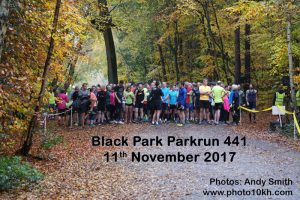
Hours 0 to 41
As I say in my profile, I’m not a complete beginner, I’ve been photographing the runners at the Black Park Parkrun on the second Saturday of odd months for long enough to have received my “25 Volunteer” t-shirt a while ago.
This post covers some of the tips I’ve picked up on the way, including much that I have learnt from George Mardall (the main Black Park Parkrun photographer).
Parkrun is a fantastic institution that is encouraging hundreds of thousands of medium fitness people to get out of bed on a Saturday morning and do something great for themselves. I am very proud of even the tiny level of support I can give it.
This is not a “know everything” post. I intent to come back to it in the future, with some hopefully major improvements.
If you have any ideas or thoughts, please post comments below.
To see more posts on other photographic topics, or to follow my learning progress, please like or follow me on the social media channel of your choice to the right.
About Parkrun
Parkrun is nationwide (now international) series of free to enter timed 5k runs that take place simultaneously at 9am every Saturday morning in over 300 public parks. The excellent website www.parkrun.com facilitates free registration, race results, statistics for each runner and photographs of each event.
At Black Park, near Stoke Poges in South Buckinghamshire, somewhere between 600-800 runners of all abilities meet every Saturday at 9am for an officially measured and timed 5K run through the woods.
I am both a regular participant and a deputy photographer. The level of photography varies by event. At Black Park it is taken very seriously by George Mardall who must have covered close to 75% of all Parkruns at Black Park since they started in 2009. (See note about George and deputies).
Preparation Pre-Event
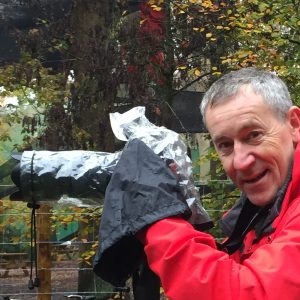
My equipment and settings:
- Fully charged battery in camera, backup battery in pocket although this has never been needed
- 70-300mm zoom lens for maximum flexibility
- Image quality Fine JPEG, the final images are going to be viewed on a 1,400 pixel wide screen at best. So there is no point shooting RAW which might also limit the speed at which I can take shots due to the time taken to write these huge files to the memory card. In fact Fine is only necessary in case I get a particularly good shot that someone requests a high definition copy of.
- Higher ISO that I would usually use. Typically, 400 but sometime 1,600 or higher. Although much better than older Sony Cameras, I still think my a99-ii is noisy at higher ISOs. George who uses a Canon, regularly shoots at 3,200 or higher without a hint of noise.
- Monopod: no-brainer when using a long lens; ease of use almost as good as handheld, with significantly improved stability.
Warm clothing. Preparation for rain: I carry a waterproof jacket, wide-brimmed hat and a rain jacket for the camera. Although this latter item takes a while to put on and makes certain settings on the camera difficult to adjust. See photo right.
Capturing the Atmosphere of the Event
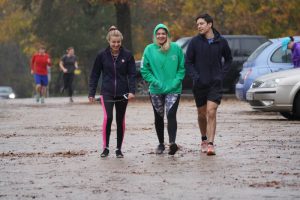
Parkrun is fun, but it should never be described as a “Fun Run.” Many runners take their weekly race very seriously and use the timed aspect to track their progress. The serious runners arrive early, warm-up with a lap or two of the lake or elsewhere, and stretch.
Other runners, including those with baby-buggies or running with dogs, have to start at the back in any case to minimise the chaos they cause, and consequently tend to arrive shortly before, and sometime after, the start.
To capture this mix, together with a feeling for the weather, particularly if it’s extreme, I take shots of people arriving in the car park, warm-up laps, stretching and the anticipation of waiting at the start.
Key camera setting: focus tracking on Auto.
The Start
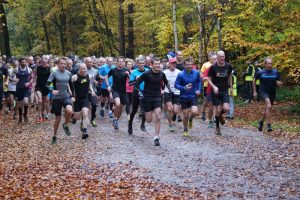
I have experimented with various positions from which to capture the start. I tend to compromise on standing to the right of the runners on the first corner so that at full zoom I can capture the start. Then zooming out for the group shots of all runners.
Force of habit means that the runners in the front row are poised to start their sports watches as the leap forward on the b of bang. This is a great spectacle and one that I capture using burst mode of 12 shots/ second.
Then when the first runnesr have cleared the corner, I try to include as many people as possible in these group shots. Lots of smiles, everybody looks good, they haven’t run anywhere yet, and the event looks like great fun.
I also hope this will give people viewing the photos the chance to see themselves early on, without necessarily having to wade through 300 images.
Team Shot of the Volunteers
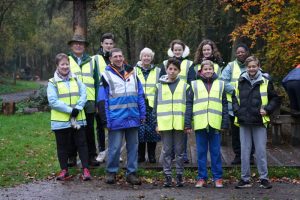
One of the most important images in the set is the team shot of the volunteer. Parkrun is entirely run by volunteers. Every week there is a core team performing the more technical tasks organising the timing, scanning of runners and uploading results to the website. This core team includes, but is by no means limited to:
- Fred Ashford and David Priddy, the race directors
- Audrey, stalwart of the team and provider of treats for the dogs – particularly Harley
- Chap with loud voice
- Lots of young people who get stationed in front of posts to stop the runner from running into them. Then more challenging scanning, timing, etc.
Apologies to all the people I didn’t name by name.
The Runners Approaching the Finish
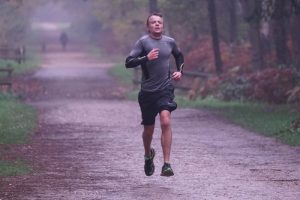
I position myself to the right of the runners just before the final bend. So the runners pass me on my right, and I usually aim to capture most of them when they are in a light area of the track. Note, in the bright sunlight of mid summer, I position myself to capture them in even shade.
Camera settings:
- focus point to top right, so that the subject (head of the runner) in focus has more space behind them than in front and consequently looks as though they are leading the field
- I have the focus mode set to centre-weighted
- Focus tracking to continuous tracking.
I am to get to position 10-12 minutes after the start. Since Mow Farrow rarely runs at Black Park, this gives me a couple of minutes before I see the leaders. In fact, Black Park is so quiet at that time in the morning that the leaders can be heard before they round the penultimate bend and come into my line of sight.
The Ideal Shot
The challenge with runners is that they can often look as though they are walking. Particularly those that are further back in the field. So ideally you capture them with both feet of the ground. This is relatively easy for the first few runners (as in the shot above), who being ahead of the field are faster and have less ground contact time. For those “in the middle of the pack”, like in the shot below, it’s more difficult.
Framing the shot, I’m looking to isolate the runner or group of runners so that they look as though they are leading the field.
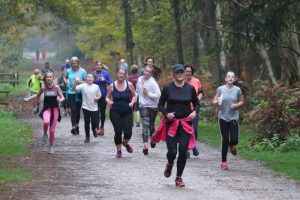
Post Processing
On an average Saturday, I will take somewhere between 500 and 1,000 shots, and aim to trim this down to about 300 to load to the website. The first task is to load everything into Lightroom. Then I can easily compare images and delete the less good.
I am looking for:
- 10-15 Images before that start that capture the atmosphere of the day, i.e., cold, rainy, sunny and the general pre-race bon hommie
- 10-15 Images of the start, having used burst mode (at 12 shots a second) until the first runners are out of sight, I typically have far too many and use 1 in 5 or even 1 out of 10. However, I try to get as many runners included in the subsequent shots as possible. These are the shots the runners will look at without having to wade through all 300
- 1 good shot of the volunteers. This is an important image, I have usually taken 5 or 6, so I just pick the best. If necessary, I will spend a few minutes adjusting the crop, levels and anything else that is necessary
- 1 shot that can form the basis of the album cover with text inserted using photoshop
- First few runners; maybe 3 of the winner and 2 each of the next couple. This is relatively easy as these runners will look as though they are flying through the air and I will have had plenty of time to take well composed shots
- The main throng is a different matter, here I’m hoping to get each runner appearing in at least one shot. With that in mind I’m picking between alternatives looking for shots which contain only whole people, i.e., I haven’t cut anybody off at the knee or included a stray arm or leg
- One good shot of each of the stragglers or group thereof; like the front runners these are relatively easy photographically as there is more time between them. These guys are less serious and there is the opportunity to catch some more fun shots.
Uploading to Flickr and the Parkrun Group/ Website
Need to install the Lightroom Flickr plugin, this is a standard process, just follow the instructions and all will work. [I used to use the Jeffrey Friedl Lightroom plugin for Flickr. Recommended by George, and he and I have found it to be more reliable than the standard Lightroom plugin. However, this has recently stopped working. So back to the Adobe standard.]
Once plugin installed:
- right click on the “Flickr” Publish Service that you will have just created, and select “Edit Settings”, change the Image Sizing to W:1,400 H:1,000
- right click again on the “Flickr” Publish Service and select “Create Album” and create an Album with the name of this Parkrun, e.g., “Parkrun999”
- Add all you images to this album
- Hit Publish
- Wait for ages for this to finish – it will be several minutes, maybe an hour or so, but you should be able to see the progress it is making
- If it fails for any reason, just hit “Publish” again and it will do some more.
Once the Album is created, open in Flickr. Go to Edit in Organisr
Finally
Remember to change camera setting back to my standard: quality RAW, ISO 200, focus tracking single shot.
Thanks and Acknowledgements
The main photographer at the Black Park Parkrun is George Mardall (See his Flickr site here). George has been covering the event for the last 8 years, pretty much since the run started. John Tipping and I are deputies, alternately covering the second Saturday of the month and filling in for George when he has other commitments.
Much of the advice above originated from George.
If you have any ideas or thoughts, please post comments below.
To see more posts on other photographic topics, or to follow my learning progress, please like or follow me on the social media channel of your choice to the right.

Your content is good as well as informative in my personal opinion. You have
truly done plenty of research on this topic.Thank you for sharing it.